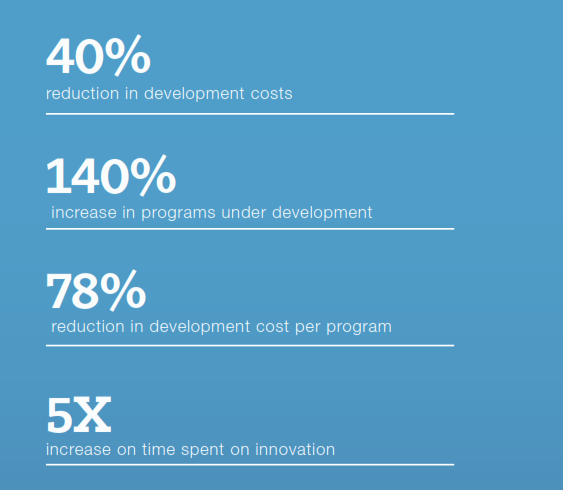Automated testing for software engineering is in demand…big time. That means large companies are looking for consulting firms to sharpen their people, processes, and tools. It also means there is serious hiring demand for the field–specifically for those who are keeping up with the latest trends and able to expand test automation to cover broader and broader scenarios.
Global automated testing is expected to be a $50 billion industry by 2020 by NASSCOM and it’s easy to see why.
Many companies, however, are still stuck in dated approaches. Being in the industry, we continuously see manual-oriented approaches that lengthen the time to delivery, increase costs, and reduce quality.
In fact, as of 2016, about only 39% of companies are using behavior-driven development and test automation (TestTalks). Similarly, in 2017, about 54% of companies do not perform unit testing (MarketWired).
That is despite seeing test automation and continuous integration companies deliver:
So let’s take a look at test automation and some of the trends to watch for, whether you run a QA organization or you’re looking to prime yourself as an in-demand employee.
What scenarios do automated testing excel at?
Automated testing can cover almost any user story or standard test scenario, but there are a few areas in which it excels most:
- Regression testing
- Load testing
- Performance testing
- Proactive testing (production environments)
Human eyes excel at random, unexpected items. For the same reason human error causes problems, it also causes unexpected benefits. As such, human manual testing continues to have value, but very much in a supplementary role.
Top automated testing tools to utilize in 2017
Whether a company looking to expand its automated testing processes or an individual looking to boost your skills, here are some of the top automated testing technologies of 2017 as showcased in an article by Dzone.
1. Selenium is designed primarily for web and responsive design tests. We utilize Selenium very creatively for a broad spectrum of UI design testing.
2. Watir is powered by Selenium and based on Ruby. It is a library for automated testing designed to interact with the web the same way humans do.
3. Wapt covers load and stress testing, designed to dive into the performance of web applications and more.
4. Apache JMeter is a broad performance testing platform allowing test automation engineers to dive deep into bigger network and multi-server scenarios.
5. The Grinder covers load testing and load injection.
6. Pylot is another load testing tool. It is lightweight and easy to get rolling with but does also contain deep and constantly evolving functionality.
7. Qtest brings the bigger picture DevOps process portions in, covering development, deployment, and quality assurance cycles. It is focused on web services, but also has solutions for a variety of specific applications.
As a bonus, I’ll include:
8. Cucumber, which enables behavior-driven development.
9. Sikuli, which is ideal for image and web recognition. We have used this tool to effectively automate testing for high-traffic video applications.
If you’re looking to further your knowledge on these and the corresponding skills to focus on for 2017, check out 15 Skills Every Software Tester Should Master in 2017 from TestingWhiz.
Top frameworks for automated testing
Apart from technologies, automated testing is a process and culture-oriented discipline.
1. Agile and DevOps: read How DevOps Improves Quality Assurance
2. Proactive and Predictive Test Practices: read Predictive Quality Assurance for Software Engineering
3. Microservices: the requirement for frequent, small, and ongoing integration testing practically demands automation. 6 Questions with a Leading Microservices Engineer.
Automated testing requires specialized knowledge and tools
It’s often best to partner with a firm that specializes in automated testing. The ramp of knowledge, tools, and practices can be very time consuming and expensive. While the benefits are enormous, the ramp can outweigh these benefits, especially when utilizing it for disparate projects.
As such, going with a company that performs automated testing regularly can shortcut this ramp, help avoid pitfalls, and reduce costs.
Ready for more?
- Read our Interview with a Leading Test Automation Engineer
- Watch DevOps Continous Integration (and Testing) in Action
- Get started with How to Get Started with DevOps
And of course, let us know your thoughts below.
[embedit snippet=”after-article-getresponse”]




